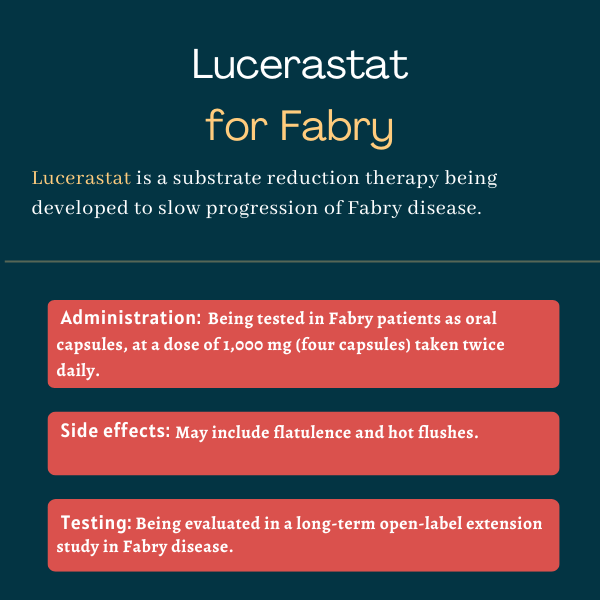
Lucerastat for Fabry disease
Last updated March 22, 2024, by Lindsey Shapiro, PhD

What is lucerastat for Fabry disease?
Lucerastat is an oral substrate reduction therapy being investigated for Fabry disease. It is designed to lessen the toxic accumulation of certain fatty molecules in cells, thereby slowing or halting organ damage in patients.
Developed by Idorsia, lucerastat has received orphan drug designation in the U.S. and the E.U. for Fabry disease. The designation provides certain incentives to encourage the development of medicines for rare diseases.
Therapy snapshot
| Treatment name: | Lucerastat |
| Administration: | Being tested in Fabry disease as oral capsules |
| Clinical testing: | Completed a Phase 3 clinical trial; open-label extension is ongoing |
How does lucerastat work?
Fabry disease is caused by mutations that lead to a lack of alpha-galactosidase A (Gal A), an enzyme critical for breaking down certain fat molecules inside cells, namely globotriaosylceramide (Gb3). Without Gal A, these molecules accumulate and lead to progressive organ damage.
A molecule on which an enzyme exerts its effects is called a substrate; Gb3 is the substrate to Gal A.
Lucerastat is a substrate reduction therapy, which essentially means that it works to reduce Gal A’s substrate, Gb3, without the need for a functional Gal A enzyme. It does that by blocking glucosylceramide synthase, an enzyme needed to make a precursor molecule of Gb3.
With less glucosylceramide synthase, less of that precursor is available to produce Gb3, which is expected to lower the levels of this fatty molecule and ease Fabry disease symptoms.
Taken by mouth, lucerastat is quickly and completely absorbed. It spreads widely to various tissues and organs, including the central nervous system, kidney, and heart, which are progressively affected in Fabry.
How will lucerastat be administered?
In clinical trials, lucerastat has been administered as hard gelatin oral capsules, each containing 250 mg of medication. The dosing regimen involved taking four capsules (1,000 mg) twice daily.
Lucerastat in clinical trials
After lucerastat’s safety was established among healthy male volunteers in Phase 1 trials (NCT02944487 and NCT02944474), Idorsia launched a Phase 1 clinical trial (NCT02930655) to investigate the therapy in 14 adults with Fabry disease.
Participants were on enzyme replacement therapy (ERT) for at least two years, and were randomly assigned to continue on ERT alone (four patients) or to receive lucerastat in addition to their ERT regimen (10 patients) for three months. Lucerastat was administered twice a day, as four hard gelatin capsules in the morning and evening, for a total daily dose of 2,000 mg.
Results showed lucerastat was well tolerated and significantly reduced blood levels of Gb3 and related fatty molecules compared with ERT only, although no effects were observed on kidney or heart function.
MODIFY trial
The MODIFY Phase 3 trial (NCT03425539) evaluated lucerastat in adults with Fabry disease who were not receiving ERT. The study enrolled a total of 118 participants, who were randomized to receive the experimental therapy (1,000 mg taken twice daily) or a placebo for six months.
The main goal was to evaluate changes in neuropathic pain (pain due to nerve damage) after six months of treatment, as assessed by the modified Brief Pain Inventory – Short Form 3. That goal was not met, with Idorsia reporting no reduction in neuropathic pain was observed with lucerastat relative to a placebo.
However, the treatment was found to be well tolerated and led to a nearly 50% reduction in Gb3 blood levels after six months, a significant difference from the placebo group, where Gb3 levels increased by 12%.
After the main trial, most participants opted to continue in an open-label extension study (NCT03737214), where all receive lucerastat for up to four years. Interim results for up to two years of treatment showed that reductions in Gb3 were maintained in the study.
While kidney function had been declining in participants before entering MODIFY, data spanning the Phase 3 trial and its extension study showed lucerastat was associated with slower declines, both compared with a placebo and with historical data collected from participants. Improvements in measures of cardiac health were also observed in several lucerastat-treated patients.
The extension study is expected to finish in 2025.

Common side effects of lucerastat
While detailed safety data from the Phase 3 trial and its ongoing open-label extension have not been reported, the Phase 1 clinical trial deemed hot flushes and flatulence as possible side effects related to lucerastat.
Other side effects reported more commonly in the lucerastat group included:
- vertigo
- low sodium levels (hyponatremia)
- bladder inflammation (cystitis)
- respiratory tract infection
- nausea and fatigue
- dizziness
- dry skin
- postmenopausal bleeding.
Fabry Disease News is strictly a news and information website about the disease. It does not provide medical advice, diagnosis, or treatment. This content is not intended to be a substitute for professional medical advice, diagnosis, or treatment. Always seek the advice of your physician or other qualified health provider with any questions you may have regarding a medical condition. Never disregard professional medical advice or delay in seeking it because of something you have read on this website.
Recent Posts
- Canada approves ERT Elfabrio for adults with Fabry disease
- I work hard to influence my health outcome with Fabry disease
- Canadian study highlights stroke danger for young adults with Fabry
- Fabry treatment ST-920 boosts kidney, heart function in trial
- Echocardiograms may spot early heart disease in Fabry, study finds
- In rare case, woman diagnosed with both Fabry and blood disorder
- Companies challenge EMA advice rejecting monthly Elfabrio dosing
- ERT may protect heart function after Fabry kidney failure
- Helping my children with Fabry find ways to combat depression
- EU agency urges against monthly dosing plan for Fabry drug Elfabrio




